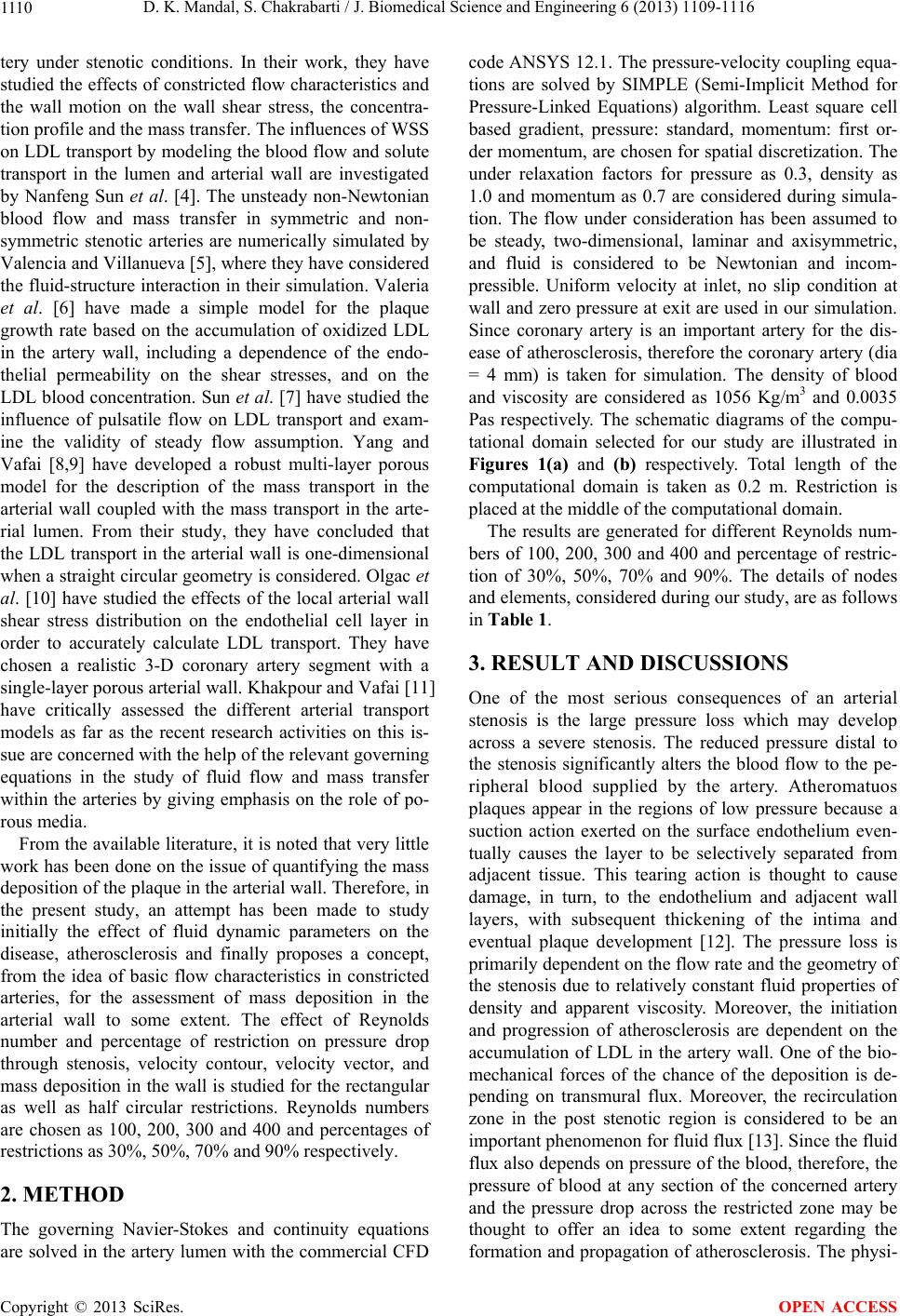
D. K. Mandal, S. Chakrabarti / J. Biomedical Science and Engineering 6 (2013) 1109-1116
1110
tery under stenotic conditions. In their work, they have
studied the effects of constricted flow characteristics and
the wall motion on the wall shear stress, the concentra-
tion profile and the mass transfer. The influences of WSS
on LDL transport by modeling the blood flow and solute
transport in the lumen and arterial wall are investigated
by Nanfeng Sun et al. [4]. The unsteady non-Newtonian
blood flow and mass transfer in symmetric and non-
symmetric stenotic arteries are numerically simulated by
Valencia and Villanueva [5], where they have considered
the fluid-structure interaction in their simulation. Valeria
et al. [6] have made a simple model for the plaque
growth rate based on the accumulation of oxidized LDL
in the artery wall, including a dependence of the endo-
thelial permeability on the shear stresses, and on the
LDL blood concentration. Sun et al. [7] have studied the
influence of pulsatile flow on LDL transport and exam-
ine the validity of steady flow assumption. Yang and
Vafai [8,9] have developed a robust multi-layer porous
model for the description of the mass transport in the
arterial wall coupled with the mass transport in the arte-
rial lumen. From their study, they have concluded that
the LDL transport in the arterial wall is one-dimensional
when a straight circular geometry is considered. Olgac et
al. [10] have studied the effects of the local arterial wall
shear stress distribution on the endothelial cell layer in
order to accurately calculate LDL transport. They have
chosen a realistic 3-D coronary artery segment with a
single-layer porous arterial wall. Khakpour and Vafai [11]
have critically assessed the different arterial transport
models as far as the recent research activities on this is-
sue are concerned with the help of the relevant governing
equations in the study of fluid flow and mass transfer
within the arteries by giving emphasis on the role of po-
rous media.
From the available literature, it is noted that very little
work has been done on the issue of quantifying the mass
deposition of the plaque in the arterial wall. Therefore, in
the present study, an attempt has been made to study
initially the effect of fluid dynamic parameters on the
disease, atherosclerosis and finally proposes a concept,
from the idea of basic flow characteristics in constricted
arteries, for the assessment of mass deposition in the
arterial wall to some extent. The effect of Reynolds
number and percentage of restriction on pressure drop
through stenosis, velocity contour, velocity vector, and
mass deposition in the wall is studied for the rectangular
as well as half circular restrictions. Reynolds numbers
are chosen as 100, 200, 300 and 400 and percentages of
restrictions as 30%, 50%, 70% and 90% respectively.
2. METHOD
The governing Navier-Stokes and continuity equations
are solved in the artery lumen with the commercial CFD
code ANSYS 12.1. The pressure-velocity coupling equa-
tions are solved by SIMPLE (Semi-Implicit Method for
Pressure-Linked Equations) algorithm. Least square cell
based gradient, pressure: standard, momentum: first or-
der momentum, are chosen for spatial discretization. The
under relaxation factors for pressure as 0.3, density as
1.0 and momentum as 0.7 are considered during simula-
tion. The flow under consideration has been assumed to
be steady, two-dimensional, laminar and axisymmetric,
and fluid is considered to be Newtonian and incom-
pressible. Uniform velocity at inlet, no slip condition at
wall and zero pressure at exit are used in our simulation.
Since coronary artery is an important artery for the dis-
ease of atherosclerosis, therefore the coronary artery (dia
= 4 mm) is taken for simulation. The density of blood
and viscosity are considered as 1056 Kg/m3 and 0.0035
Pas respectively. The schematic diagrams of the compu-
tational domain selected for our study are illustrated in
Figures 1(a) and (b) respectively. Total length of the
computational domain is taken as 0.2 m. Restriction is
placed at the middle of the computational domain.
The results are generated for different Reynolds num-
bers of 100, 200, 300 and 400 and percentage of restric-
tion of 30%, 50%, 70% and 90%. The details of nodes
and elements, considered during our study, are as follows
in Table 1.
3. RESULT AND DISCUSSIONS
One of the most serious consequences of an arterial
stenosis is the large pressure loss which may develop
across a severe stenosis. The reduced pressure distal to
the stenosis significantly alters the blood flow to the pe-
ripheral blood supplied by the artery. Atheromatuos
plaques appear in the regions of low pressure because a
suction action exerted on the surface endothelium even-
tually causes the layer to be selectively separated from
adjacent tissue. This tearing action is thought to cause
damage, in turn, to the endothelium and adjacent wall
layers, with subsequent thickening of the intima and
eventual plaque development [12]. The pressure loss is
primarily dependent on the flow rate and the geometry of
the stenosis due to relatively constant fluid properties of
density and apparent viscosity. Moreover, the initiation
and progression of atherosclerosis are dependent on the
accumulation of LDL in the artery wall. One of the bio-
mechanical forces of the chance of the deposition is de-
pending on transmural flux. Moreover, the recirculation
zone in the post stenotic region is considered to be an
important phenomenon for fluid flux [13]. Since the fluid
flux also depends on pressure of the blood, therefore, the
pressure of blood at any section of the concerned artery
and the pressure drop across the restricted zone may be
thought to offer an idea to some extent regarding the
formation and propagation of atherosclerosis. The physi-
Copyright © 2013 SciRes. OPEN ACCESS